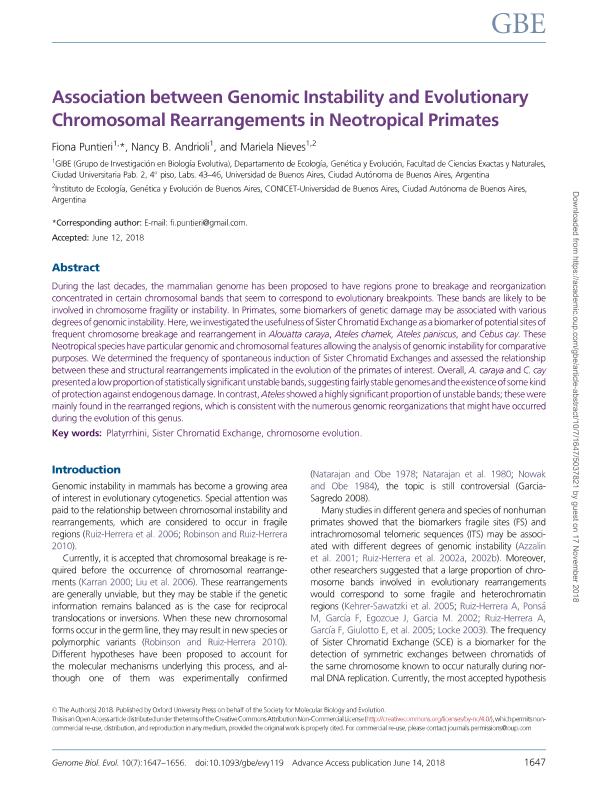Mostrar el registro sencillo del ítem
dc.contributor.author
Puntieri, Fiona

dc.contributor.author
Andrioli, Nancy Beatriz

dc.contributor.author
Nieves, Mariela

dc.date.available
2022-12-27T13:14:21Z
dc.date.issued
2018-07
dc.identifier.citation
Puntieri, Fiona; Andrioli, Nancy Beatriz; Nieves, Mariela; Association between genomic instability and evolutionary chromosomal rearrangements in neotropical primates; Oxford University Press; Genome Biology and Evolution; 10; 7; 7-2018; 1647-1656
dc.identifier.uri
http://hdl.handle.net/11336/182490
dc.description.abstract
During the last decades, the mammalian genome has been proposed to have regions prone to breakage and reorganization concentrated in certain chromosomal bands that seem to correspond to evolutionary breakpoints. These bands are likely to be involved in chromosome fragility or instability. In Primates, some biomarkers of genetic damage may be associated with various degrees of genomic instability. Here, we investigated the usefulness of Sister Chromatid Exchange as abiomarker of potential sites of frequent chromosome breakage and rearrangement in Alouatta caraya, Ateles chamek, Ateles paniscus, and Cebus cay. These Neotropical species have particular genomic and chromosomal features allowing the analysis of genomic instability for comparative purposes. We determined the frequency of spontaneous induction of Sister Chromatid Exchanges and assessed the relationship between these and structural rearrangements implicated in the evolution of the primates of interest. Overall, A. caraya and C. cay presenteda lowproportionof statistically significant unstablebands, suggesting fairly stablegenomes andtheexistenceof somekind of protection against endogenous damage. In contrast, Ateles showed a highly significant proportion of unstable bands; thesewere mainly found in the rearranged regions, which is consistent with the numerous genomic reorganizations thatmight have occurred during the evolution of this genus.
dc.format
application/pdf
dc.language.iso
eng
dc.publisher
Oxford University Press

dc.rights
info:eu-repo/semantics/openAccess
dc.rights.uri
https://creativecommons.org/licenses/by-nc/2.5/ar/
dc.subject
CHROMOSOME EVOLUTION
dc.subject
PLATYRRHINI
dc.subject
SISTER CHROMATID EXCHANGE
dc.subject.classification
Biología

dc.subject.classification
Ciencias Biológicas

dc.subject.classification
CIENCIAS NATURALES Y EXACTAS

dc.title
Association between genomic instability and evolutionary chromosomal rearrangements in neotropical primates
dc.type
info:eu-repo/semantics/article
dc.type
info:ar-repo/semantics/artículo
dc.type
info:eu-repo/semantics/publishedVersion
dc.date.updated
2022-12-27T11:00:20Z
dc.identifier.eissn
1759-6653
dc.journal.volume
10
dc.journal.number
7
dc.journal.pagination
1647-1656
dc.journal.pais
Reino Unido

dc.journal.ciudad
Oxford
dc.description.fil
Fil: Puntieri, Fiona. Universidad de Buenos Aires. Facultad de Ciencias Exactas y Naturales. Departamento de Ecología, Genética y Evolución. Grupo de Investigación de Biología Evolutiva; Argentina
dc.description.fil
Fil: Andrioli, Nancy Beatriz. Universidad de Buenos Aires. Facultad de Ciencias Exactas y Naturales. Departamento de Ecología, Genética y Evolución. Grupo de Investigación de Biología Evolutiva; Argentina
dc.description.fil
Fil: Nieves, Mariela. Consejo Nacional de Investigaciones Científicas y Técnicas. Oficina de Coordinación Administrativa Ciudad Universitaria. Instituto de Ecología, Genética y Evolución de Buenos Aires. Universidad de Buenos Aires. Facultad de Ciencias Exactas y Naturales. Instituto de Ecología, Genética y Evolución de Buenos Aires; Argentina. Universidad de Buenos Aires. Facultad de Ciencias Exactas y Naturales. Departamento de Ecología, Genética y Evolución. Grupo de Investigación de Biología Evolutiva; Argentina
dc.journal.title
Genome Biology and Evolution
dc.relation.alternativeid
info:eu-repo/semantics/altIdentifier/doi/http://dx.doi.org/10.1093/gbe/evy119
dc.relation.alternativeid
info:eu-repo/semantics/altIdentifier/url/https://academic.oup.com/gbe/article/10/7/1647/5037821
Archivos asociados
